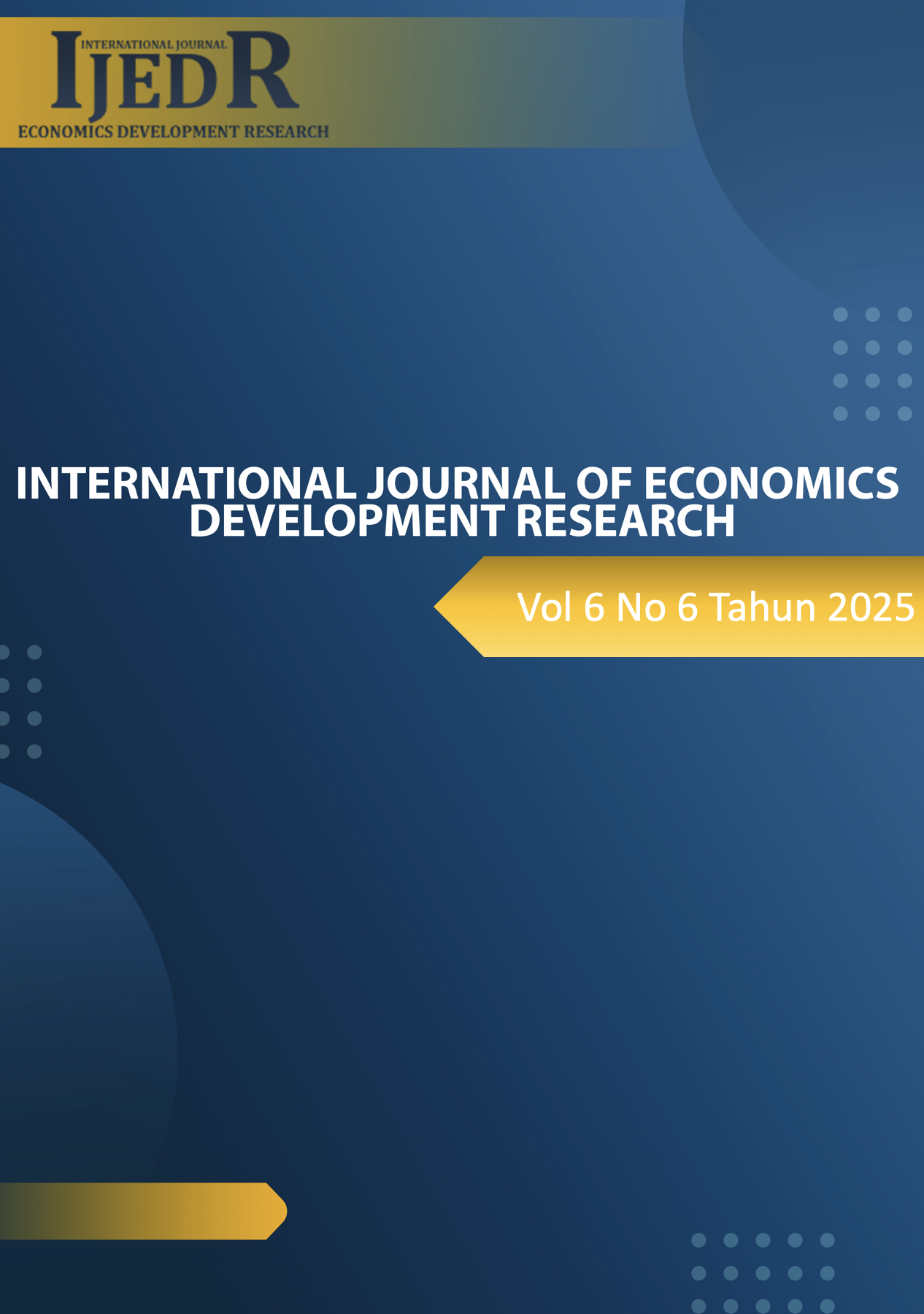Development Inequality Between Regencies/Cities and Its Impact on Population Migration within the Province of West Nusa Tenggara Period 2020–2024
DOI:
https://doi.org/10.37385/ijedr.v6i6.9423Keywords:
Development Inequality Population Migration Fixed Effect Model West Nusa Tenggara Province NTBAbstract
This research examines the influence of development inequality between districts/cities on population migration in West Nusa Tenggara Province (NTB) in 2020–2024. Using a panel data approach and the Fixed Effect Model (FEM) method, The present research examines six independent variables, Gross Regional Domestic Product (GDP) per capita, poverty rate, education level, infrastructure, open unemployment rate, and Human Development Index (HDI), on inward migration as dependent variables. Empirical results based on the Fixed Effect Model estimate show that partially, the variables of infrastructure, unemployment, and HDI have a significant effect on inward migration, while other variables do not. Simultaneously, all independent variables had a significant effect with an adjusted R² value of 70.11%, indicating that the model has a strong ability to explain interregional migration. Based on these results, this study recommends equitable development policies through poverty alleviation based on local empowerment, improving the quality of infrastructure and education, and creating productive jobs to reduce inequality and control unbalanced migration flows between regions.
References
Anwar, B., & Syahputra, H. (2021). Determinants of internal migration in Indonesia: A logit approach. Journal of Economics and Development, 22(2), 150–165.
Arifin, M. (2025). The role of digital payments in driving regional economic growth: Evidence from Indonesian provinces. Journal of Regional Development Studies, 33(1), 45–62.
West, B. P. S. P. N. T. (2021). Statistics of districts/cities throughout NTB Province in 2021. BPS NTB Province.
Firmansyah, R., Dewi, S., & Pratama, A. (2024). The initial impact of the COVID-19 pandemic on regional inequality in Indonesia. Sustainability, 15(18), 13709. https://doi.org/10.3390/su151813709
Friedmann, J. (1966). Regional development policy: A case study of Venezuela. MIT Press.
Ghozali, I. (2011). Multivariate Analysis Application with IBM SPSS 19 Program. Publishing Agency of Diponegoro University.
Ghozali, I. (2021). Analisis Multivariat dan Ekonometrika: Teori, Konsep, dan Aplikasi dengan EViews 12. Badan Penerbit Universitas Diponegoro.
Hakim, L., & Rosini. (2022). Regional income inequality in Indonesia: The role of public and private investment. Journal of Indonesian Development Economics, 10(3), 211–228. https://doi.org/10.20885/ejem.vol15.iss2.art4
Handayani, R., & Prabowo, T. (2023). Education and infrastructure in reducing inequality in Indonesia. Journal of National Development, 13(1), 50–65.
Iqbal, M. (2015). Applied Econometrics: Theory and Applications with EViews. BPFE Yogyakarta.
Kurniawan, A. (2008). Quantitative Research Methods: Theory and Applications to Economics and Business. Alphabet.
Lee, E. S. (1966). Migration theory. Demography, 3(1), 47–57. https://doi.org/10.2307/2060063
Lee, E. S. (1975). Population redistribution and economic growth: United States, 1870–1950. American Philosophical Society.
Lestari, W., & Gunawan, A. (2021). Inequality and regional migration in Central Java. Journal of Regional Economics, 8(3), 180–195.
Perroux, F. (1955). Note on the notion of growth pole. Ekonomi Appliqué, 8, 307–320.
Prasetyo, A., & Rahmawati, N. (2021). Migration is influenced by employment and educational opportunities. Indonesian Journal of Demography, 9(1), 75–90.
Rahman, F., & Nurhayati, S. (2023). Development disparity in NTB: An analysis of Williamson and Theil. Journal of Regional Economics, 15(2), 122–135.
Ramadhan, A., & Putri, R. (2022). Analysis of the relationship between development and migration in NTB. Journal of Development and Migration, 11(4), 210–225.
Sari, D., & Putra, R. (2018). Development inequality in Bali with the Williamson Index. Journal of Regional Economics, 10(2), 100–115.
Sodik, M., Fadli, R., & Hasan, A. (2023). Regional development and income inequality in Indonesia: The role of human resources. Journal of Emerging Market Economics, 15(2), 145–160. https://doi.org/10.20885/ejem.vol15.iss2.art4
Susanti, D., & Hidayat, M. (2019). Development inequality in NTB with the Williamson and Theil Index. Journal of Development Economics, 20(2), 115–130.
Syafruddin, R. (2022). Infrastructure, education, and migration in South Sulawesi. Journal of Regional Economics, 12(1), 88–104.
Taufiqurrahman, M. (2023). Regional inequality, human resources, and unemployment in Indonesia. Cogent Economics & Finance, 11(1), 2251803. https://doi.org/10.1080/23322039.2023.2251803
Todaro, Member of Parliament (1970). Labour migration and urban unemployment models in less developed countries. In The American Economic Review (Vol. 59, Issue 1).
Widarjono, A. (2018). Econometrics: Introduction and Its Application Accompanied by an EViews Guide. UPP STIM YKPN.
Williamson, J. G. (1965). Regional inequality and national development processes: A description of patterns. Economic Development and Cultural Change, 13(4), 1–84. https://doi.org/10.1086/450136
Yusuf, A., & Kurniawan, D. (2020). Determinants of regional inequality in Eastern Indonesia. Journal of Emerging Market Economics, 12(3), 200–215.





